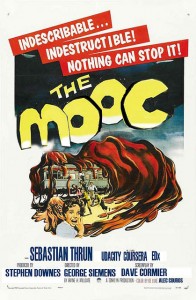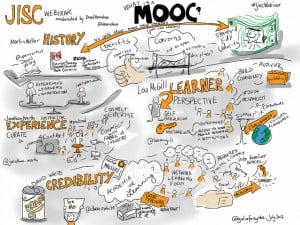Who said this, and to what was he referring?
 Yes, it was a ‘he’, John Daniel no less, who included this bold claim in his recent paper ‘Making Sense of MOOCs: Musings in a Maze of Myth, Paradox and Possibility‘. In claiming that “this is the real revolution of MOOCs”, he explains that
Yes, it was a ‘he’, John Daniel no less, who included this bold claim in his recent paper ‘Making Sense of MOOCs: Musings in a Maze of Myth, Paradox and Possibility‘. In claiming that “this is the real revolution of MOOCs”, he explains that
“Placing their xMOOCs in the public domain for a worldwide audience will oblige institutions to do more than pay lip service to importance of teaching and put it at the core their missions.”
You’d better read it twice to make sure you understand what he’s getting at. Better still, you’d better read the whole article, as it’s currently the best you’ll find about the status and prospects of MOOCs (and there’s plenty to choose from!). I won’t attempt to summarise it (Tony Bates does here – make sure you read the comments, especially the one from Stephen Downes), but strongly agree that it will be the quality of the teaching that will be the determinant of the success or otherwise of MOOCs.
And they will improve rapidly, as institutions feel the pressure from users to provide a better teaching and learning environment, and companies like Coursera and edX respond with ‘new and improved’ features to their models.
Those who currently don’t perceive much of a threat from MOOCs should heed Daniel’s deliberate and considered use of ‘revolution’. I’m not claiming they have their heads in the sand, but much of their musing is from the perspective of currently available xMOOCs, many of which lack fundamental educational features.
Typical is the reaction of an academic from Ursinus College, who has written about his experience with a MOOC run by Coursera. Jonathan Marks presents ‘Who’s afraid of the big bad disruption‘ in Inside Higher Education. Jonathan teaches politics, and recently decided to sign up with Coursera to see how a leader in the field, Ezekiel Emanuel, teaches ‘Health Policy and the Affordable Care Act’.
 Jonathan optimistically concludes that:
Jonathan optimistically concludes that:
“… colleges like mine have little to fear from Coursera and its cousins. They are in the self-improvement business. We are in the self-formation business.”
Hmm, OK, but watch out as the MOOCs evolve to become an even more attractive option for more and more learners. At the moment they are primarily the province of working adults, but once cash-strapped younger students calculate the costs and realise the benefits (as real credit becomes more prevalent), the revolution could (will?!) hit hard.
Searching for suitable pics for this post, I went to Photopin (alert readers will have noticed my now-frequent use of this site, an offshoot of Flickr) and found the great illustrations you see here. I mention this because the name Giulia Forsythe keeps coming up with these stylish creations, so I did a little digging.
 Lo and behold, it seems that her inspiration is drawn from her experience in a MOOC! Specifically, ‘Her own lifelong learning journey has been enriched through participation in Massively [sic] Open Online Courses, most notably, DS106.’ Go on, have a look at DS106 (Computer Science 106: Digital Storytelling, from the University of Mary Washington), especially if you’re interested in visual literacy.
Lo and behold, it seems that her inspiration is drawn from her experience in a MOOC! Specifically, ‘Her own lifelong learning journey has been enriched through participation in Massively [sic] Open Online Courses, most notably, DS106.’ Go on, have a look at DS106 (Computer Science 106: Digital Storytelling, from the University of Mary Washington), especially if you’re interested in visual literacy.
I haven’t checked closely, but I suspect that it’s a cMOOC rather than an xMOOC (read the Daniel article if you don’t know the difference). Methinks the revolution will occur if and when XMOOCs become more like cMOOCs.
photo credit: giulia.forsythe via photopin cc
photo credit: giulia.forsythe via photopin cc
photo credit: giulia.forsythe via photopin cc